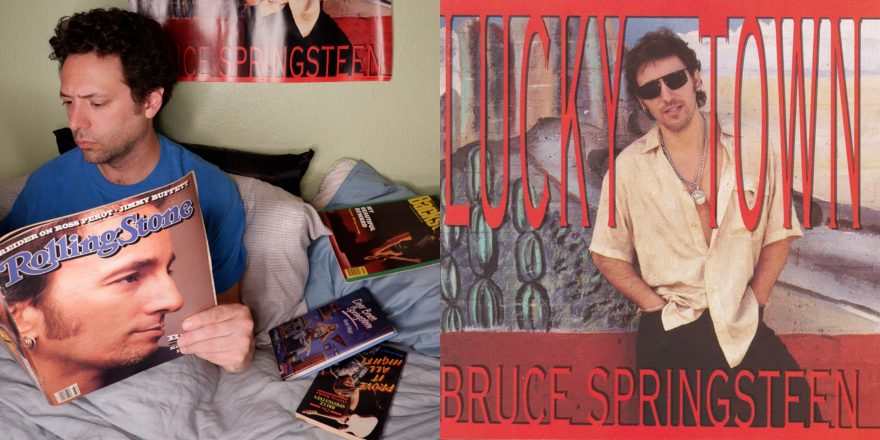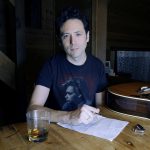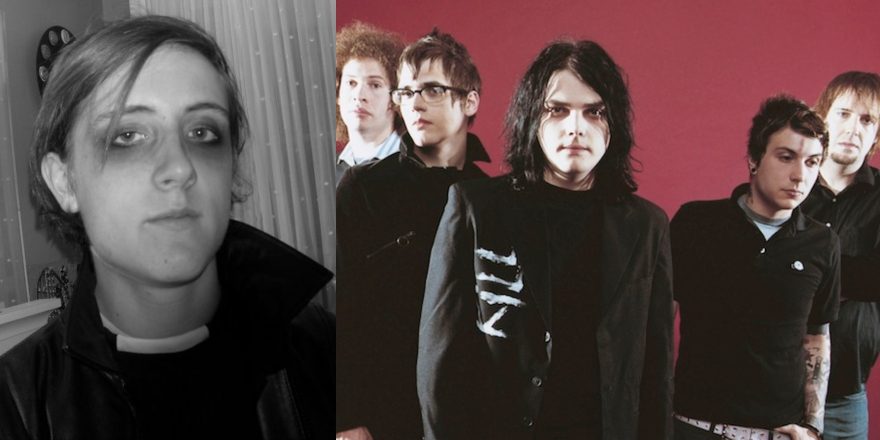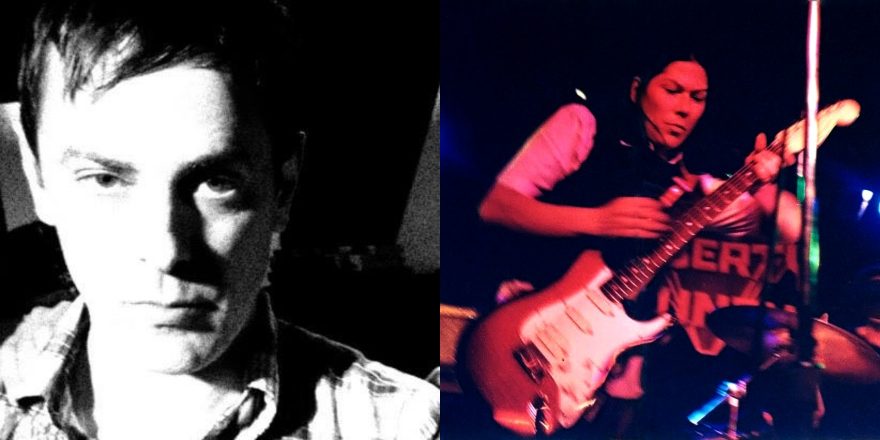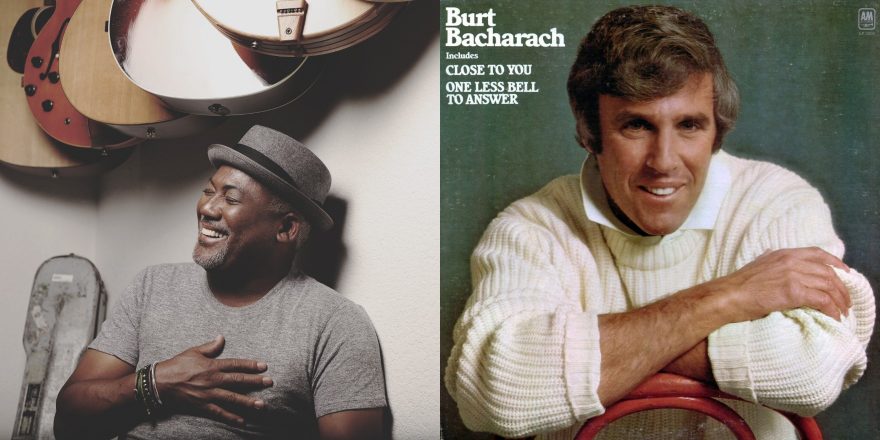On the night of Monday, March 30, 1992, I stood in line at a Cincinnati record store surrounded by Def Leppard fans. As the clock struck midnight, copies of Adrenalize were sold hand over fist. I had nothing in common with their purchasers; I wasn’t there for Hysteria’s follow-up. A 17-year-old high school senior, out past curfew back when records were only released on Tuesdays (the way God intended), I was fifth in line to trade cash for two compact disc long-boxes: Bruce Springsteen’s Human Touch and Lucky Town albums.
These were tough times to be a Springsteen fan, and not just because these were his first records since dismissing the E Street Band. Music was, thankfully, changing, but I remained an overly-committed fan. As a fourth grader, Born in the U.S.A. tuned me in with sing-alongs about identity and socio-politics that were slightly over my head. Next up was Tunnel of Love, a record released when I was in eighth grade. I can’t claim to have grasped it at the time, but that didn’t stop me from buying my first bolo tie and somehow making it 230 miles north to see the tour. (Q: Are you a 13-year-old who wants to isolate yourself from other kids in 1987? A: Cosplay as the cover of Tunnel of Love.)
I explored a lot of different music between Tunnel of Love and that midnight sale, but there was a clear trend: old white men with guitars. Well, only “old” from a teenager’s point of view. I spent afternoons in Grateful Dead parking lots of the late ‘80s and early ‘90s, eating grilled cheese in the drugged-out corners next to rich kids, doctors, and true Heads. I owned five Lou Reed solo records before ever knowing of the Velvet Underground’s existence (FYI: If you look at my senior high school yearbook photo, I did not ask my hairdresser for a mullet; I just handed her the album cover for Songs for Drella). I hitchhiked to Tom Petty’s Full Moon Fever tour. I was the first person in history (this is documented) who was grounded for going to see Arlo Guthrie (there had recently been a stabbing outside the same club courtesy of King Diamond’s wayward fans). I stood outside Warren Zevon’s tour bus for three hours to shake his hand while listening to two 40-year-old Excitable Boys tell me how to get “pecker tracks” out of leather automobile upholstery. I sat in the third row for Neil Young & Crazy Horse on the Ragged Glory tour, barely processing Sonic Youth and eating a soft pretzel in the lobby during Social Distortion. And there were Dylan shows, a lot of Dylan shows.
I listened to some newer music, but barely: R.E.M., Tracy Chapman, and a few Jesus and Mary Chain albums were favorites. There were a handful of other women I owned records by: Bonnie Raitt, Michelle Shocked, Elizabeth Cotten, and Edie Brickell. But, mostly, I was obsessed with 40-plus dudes with guitars who wrote their own songs, not exactly the music enjoyed by my peers. But why? Was I hoping to learn something from them? Did I hope to find answers to life’s big questions? A road map out of the misery of my adolescence? A father figure?
Yes, yes, yes, and yes.
And what better rock star for a 17-year-old white kid from the suburbs to direct his contrarian and artistic attention to than the seemingly has-been aphoristic poet with an electric guitar known as Bruce Springsteen? The books I was reading at the time all concerned themselves with identity: D.H. Lawrence, James Joyce, W. Somerset Maugham. From 1973’s Greetings from Asbury Park, N.J. to 1992’s Human Touch/Lucky Town double bill, when strung together, offer a similar bildungsroman, but they served as more immediate companions than paperbacks. It was more fun to brood alone with a Walkman than a reading light.
I spent that spring studying Human Touch and Lucky Town—the players, the sound, the arrangements, the photos, the liner notes—but mostly the content of the songs. The examination was confusing, mostly because of how different the two records were from one another. Human Touch has a few good, easily digestible songs on it; My adult-contemporary bone wiggled to the title track, programmed to loop on my Sony five-disc CD carousel. A few songs—“Soul Driver,” “57 Channels (And Nothin’ On),” “Real World,” “Roll of the Dice”—I knew from a 1990 bootleg recording of his Christic Institute benefit performance where he played them solo almost two years prior. I kept going back to the bootleg versions, bare and spare. It made the album takes feel canned and insincere. But I kept trying and trying, and I listened to the record for months, but it never fully clicked for me—a first for a Springsteen record.
When I wasn’t listening to Human Touch, I was listening to Lucky Town, a record that immediately captured my imagination with Springsteen’s blown-out vocal, loud, thin guitar, and gut-bucket imagery. But, to my disappointment, I couldn’t relate to a single lyrical detail. He was singing about his new-ish “better days” and being a “rich man in a poor man’s shirt.” The relationships weren’t the wild romance of his early records at Greasy Lake, but a new, adult chapter that took place past the exit signs of Tunnel of Love, somewhere in the daylight. The songs acknowledged family and faith. His worries seemed more external, his internal clock more patient. There was a sense of calm, not just in ballads like “My Beautiful Reward,” but also in the rockers, like “Living Proof,” that sounded musically raw, but lyrically expressed a sense of gratitude and wonder.
As an angry, peak-pubescent malcontent, this meant nothing to me. I was desperate and searching and my hero sounded… happy? Yet, I was deeply drawn to the record. Was it just the guitar and harmonica solos, turns of poetic phrases, open-room drum sound, and the finger-picked acoustics that kept me circling back? Or had my hero-worship turned into the kind of fawning that causes fans to over-empathize and take pleasure in their VH1 God’s redemption? If this is an album about Bruce becoming happy, how did this happen and why do I want to listen to it?
In my search for meaning and understanding, I paid $3.99 for the August issue of Rolling Stone with Springsteen’s stubbled mug on the cover and an interview with James Henke. The interview became my companion, the footnotes to my new records. I poured over it, analyzing every line, building connections to the songs, and uncovering the albums’ mysteries with a manic energy more Monk than Columbo. Springsteen discussed the pain of divorce and reasons for breaking up his E Streeters. He justified his New Jersey expat move to California and chatted about record shopping, name-checking Sir Mix-A-Lot and Faith No More. He discussed life in the Hollywood Hills and the difficulty of learning to enjoy his money.
He didn’t seem to recognize that all this made him appear even more removed from his audience and characters than his detractors had thought. But despite appearing out of touch with the world, he was clearly more in touch with himself. The part I re-read the most was when he discussed seeing a therapist; He talked about learning how to put down the guitar as a way to remove the barrier that guarded him from his deeper feelings and the ability to have sustaining relationships. He talked about self-hate, escapism, intimacy, and the love of a spouse and parent. In the song “Better Days” on Lucky Town, he sang “It’s a sad man, my friend, who’s livin’ in his own skin/And can’t stand the company.”
Classic Bruce! Just out of high school in the early ‘90s, I didn’t know anyone who saw a therapist. If I knew anyone taking medication for anxiety or depression, they weren’t talking about it. It fascinated me that this 42-year-old who had already imparted his joy and wisdom through his songs into my life was just figuring himself out now and that he needed a therapist. Springsteen discussed Human Touch as the transitional album, the wilderness years that bridge Tunnel of Love to Lucky Town. But Lucky Town was the album he was referring to when he discussed his therapy’s sweat equity. It was his recorded document of the beautiful mess that a person can become when they open themselves to all the happiness and sadness that life will allow. He never used the words “mental health,” but I knew what he was talking about from books and English classes—this was the familiar theme of “Man vs. Himself.” I dwelled on this for a few days, re-listening to Lucky Town almost exclusively, and then tucked my copy of Rolling Stone away in my closet.
I entered college at Ohio State University later that year, and Bruce was still on my mind and my Walkman as I hiked to class across the massive campus. I sorted out ways to travel to see other shows on the tour, while wearing myself out between hanging out in music clubs, taking on a stressful course load, late nights that saw the dawn, chasing girls, internal pressures, practicing guitar, trying to write, eating trucker speed, adjusting to new freedoms and responsibilities, and a lot of partying. This didn’t become so much a phase as it did a lifestyle.
My sophomore year, I moved out of the dorms and into my own apartment, but nothing about my lifestyle had settled down. My predisposition for being extremely sensitive, hard on myself, and having expectations that exceeded reality for everyone and everything I encountered began to mix in self-destructive ways that affected my daily living. My grades, once very good, began to suffer. My nights got longer and my health deteriorated. I had girlfriends, but only for a few weeks at a time. My only stability was my friendships. By mid-year, I had bleeding ulcers and I was restless in a new way. My family physician back home asked me a few health-related questions at my check-up. He struck a nerve and I broke into tears. Well, not tears, really, but more like sobbing that lasted for several days. He recommended that I see a psychiatrist and begin addressing all these things that were eating me up.
A shrink? I couldn’t, I thought. I was 19.
Beginning to see a psychiatrist was scary, and I told very few people what was happening. I told one close friend, only because I borrowed his car to drive to the appointment each week. Conversations about how to get to my appointment and whether insurance would cover them distracted me from my fear of being vulnerable with a stranger. All of sudden, it didn’t matter that I had something in common with the poster boy on my wall, but it did help me drive down the road and walk inside an office. My first psychiatrist told me at my initial visit that I looked like Abraham Lincoln. At my second appointment, he put me on Lithium Bicarbonate. I took my medicine, but I didn’t feel great about it. It felt rushed and impersonal. I knew nothing about diagnoses and even less about specific pills, but I did know that I needed to try something and trust someone. After four appointments, my health worsened. I contracted mononucleosis, dropped out of school, and spent all of spring quarter on my parents’ couch, sleeping and watching TV.
During my first week back home, Kurt Cobain died and, although his music didn’t resonate with me at the time as it did with my friends, his suicide did. I watched MTV for hours, daily. I never felt disconnected from his sadness or wondered how a famous musician could be in so much pain—you could see it in his eyes and hear it in his voice. I don’t think I was ever suicidal, but I was in a very dark place and the only thing that protected me from it being darker were my daydreams and ambition that I had yet to explore. I wanted to make records, write books, travel, and fall in love. But I kept thinking, “He achieved his dreams, and the bad shit still didn’t go away.” My days were filled with naps and television, still taking my lithium. For my first trip out of the house in months, I drove three miles to Blockbuster. A few days later, I tried walking to the bowling alley, but didn’t make it all the way and had to rest at a friend’s parents’ house until my mom could pick me up after work. I wasn’t as manic and I wasn’t as depressed, but I was a zombie with an extremely low white blood cell count. A few weeks later, feeling a bit better, I drove across the river to Northern Kentucky University to see Guy Clark. A few weeks after that, I started pulling afternoon shifts at the dry cleaner/tuxedo rental shop where I had worked in high school. I was on the mend.
By June, it was time to go back to my apartment in Columbus and re-enroll in classes. I knew I had to pick up where I left off, and this meant finding a new, more engaged, psychiatrist. I started seeing a doctor that was in his residency program at OSU. This felt better to me right away. I could walk the two miles there and back and my illness wasn’t connected to his BMW payment, so his treatment felt sincere. At the first visit, we talked about my previous experience with a psychiatrist, the medicine I was taking, and music. He didn’t have much to say about Springsteen, but he did mention that he saw Harry Chapin perform when he was first starting out in the loft of a tiny guitar shop (and, hey, in terms of cultural relevance, it was better than being called Abraham Lincoln). I kept going back.
Cassettes of Graham Parker’s Burning Questions, Peter Himmelman’s Strength to Strength, John Wesley Harding’s It Happened One Night, Chris Whitley’s Living with the Law, and Hank Williams’ Beyond the Sunset fueled my Walkman, back and forth each week, along with Lucky Town, which I came back to over and over that whole summer. Eventually, the new doctor weaned me off the lithium. It was never determined if it was a bad idea in the first place, since he didn’t know me before the pills, but I haven’t needed them since. I kept seeing that psychiatrist for the next year and a half until the student doctor and I set a date to say goodbye. We marked it on the calendar and, despite losing my step-mother the week prior, we kept the date.
In his memoir, Born to Run, Springsteen documents his years of therapy, the bumps and breakthroughs. The most moving moments in the book were about his childhood traumas and mental health struggles. This is the stuff that doesn’t go away. It’s the stuff that lives inside us and that we can address and try to make sense of with medication, therapy, the support of loved ones, and whatever tools we have available that work for us as individuals.
Now, in my early 40s, I’ve made my fair share of records, solo and with my old band, The Black Swans. None of them aimed for the populism or politics Springsteen sought and achieved, nor have they sold very well, but they have provided me with a small audience, a community of friends, and a place to hang my art. My therapy and medication that ended after just a couple of years helped me develop the life-long self-help strategies I need to stay healthy. In my early 30s, I began working in social services. I started in vocational rehabilitation to help adults with disabilities obtain and maintain employment, then taught mental health awareness and de-stigmatization courses, before returning to vocational rehabilitation to work with young adults with disabilities in their transition from school to work. Periodically, I produce records for older musicians whom I greatly admire who have been marginalized by commercialism, bad luck, and bad decisions.
I found that these jobs give me a sense of purpose; they help combat the negative, materialistic, and inescapable things that the world challenges us all to endure. It makes me feel good to do something positive for others (never to be underestimated) and it balances out the self-absorption it requires to be an artist. It’s all a work in progress, for certain, as my relationship with myself and the people I love continue to change and, hopefully, improve with fine-tuning. The push and power of records—their swirl of sound, language, and composition—never ceases to amaze me. They pull us off the couch to dance, they comfort us in our loneliest moments, and they accompany us in sickness, in health, and that weird, fuzzy space in between the two. Some records that we love reflect a world nothing like our own. Others re-affirm or remind us of some forgotten part of who we are or who we hope to someday be.
It turns out, I did love Lucky Town for the album it is—its brashness and its poetics, its urgency and celebration of adulthood—and not out of some sycophant’s sentimentality. “If I Should Fall Behind,” “My Beautiful Reward,” “Living Proof,” and the title track are some of the best songs and performances Springsteen has ever recorded. As I inevitably evolved from an old kid to a young adult, the record stayed the same. As years passed I heard the album’s ultimate coda, louder and louder. It’s a celebration of learning to accept and love yourself more and, by doing so, learning to better love others. It taught me that if Bruce can try to be a happier and healthier person, maybe I can too.
(Photo Credit: Eve Searls)


